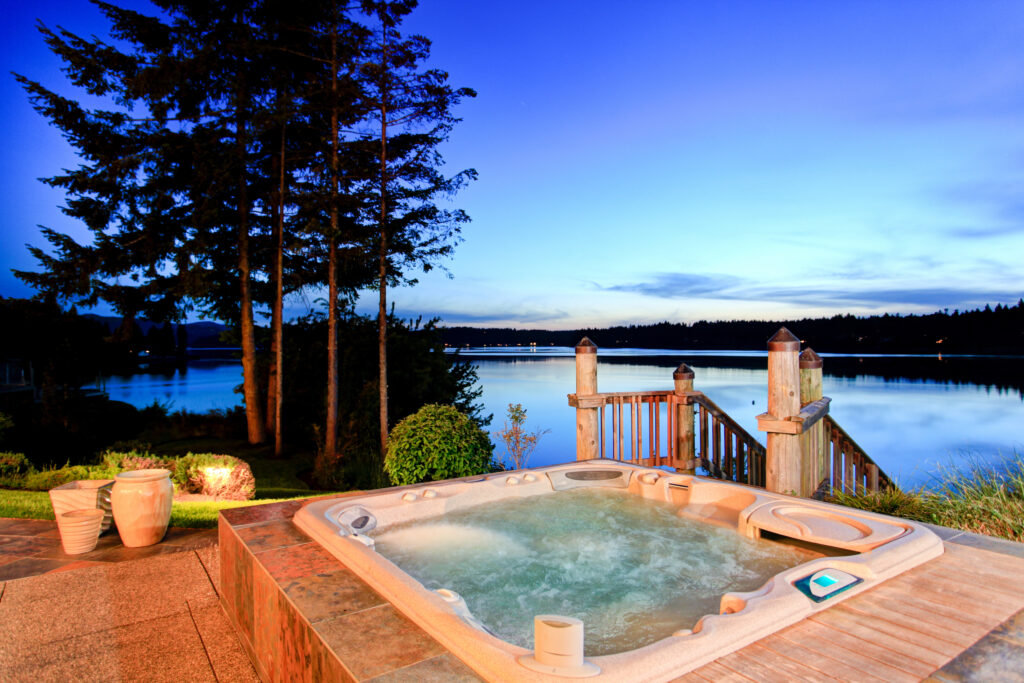If you’ve got a hot tub, you’ll need to make sure you maintain it on a regular basis, but does this include adequately insulating underneath it?
Depending on the style and construction of your hot tub, you’ll almost certainly need to insulate under it. For example, if you have an inflatable hot tub, you’ll need to insulate against potential damage, but most hot tubs should be insulated anyway, to prevent heat dissipation through the ground.

Read on to learn more about hot tubs, why they’re so popular, and how you should maintain them.
Feeling Hot, Hot Tub
Humans have been reaping the benefits of hot water for millennia, with the earliest examples being hot spring bathing. It’s believed that humans have enjoyed bathing or lounging in hot springs for as long as they’ve existed, or since the two first came together.
To explain it as simply as possible, bathing in hot water feels great. It’s a practice that is thought to bring with it a whole host of health benefits, from increased blood circulation and stress reduction to better sleep cycles and even pain relief.
Even today, with advancements in modern medicine and health technology, there are plenty of people who still bathe in hot springs. There are increased benefits to be found in the water that makes up a hot spring, such as minerals, including a high silica content that smooths and softens skin.
However, there are plenty of alternatives to hot springs these days, such as the hot tubs that are commonplace in luxurious homes and spas. They’re fantastic alternatives, offering unmatched levels of relaxation and recuperation through the healing power of hot water and powerful jets.
Although bespoke, purpose-built hot baths can be found throughout history as far back as four thousand years ago, modern hot tubs are a relatively recent invention. It’s thought that the first home spas and hot tubs originated in California in the late 1950s.
They were typically crafted from old barrels and vats, and they weren’t very technologically advanced. Regardless, they grew in popularity throughout the sixties, despite being riddled with issues.
As they were crafted from poorly-insulated wood, they were prone to leaks, and the wood made for a natural breeding ground for bacteria and algae. There were little-to-no cleaning or filtration systems, and as a result, development was encouraged.
Reportedly, the first plastic and fiberglass hot tubs emerged into the market at the end of the 1960s, and the face of the home spa industry was changed forever. In fact, it was in 1968 that Roy Jacuzzi invented the world’s first ‘whirlpool bath’ – you might just recognize his name.
Maintaining The Investment
These days, there are countless hot tub brands on the market, and they tend to be available in a wide range of styles, builds, and purposes.
For example, the range tends to start with affordable and basic inflatable constructions, but it can quickly climb to multi-person, highly advanced spa-grade hot tubs. While you can invest in a hot tub for as little as two or three hundred dollars, the most expensive examples can easily run up bills of more than twenty or thirty thousand dollars.
However, it isn’t just buying a hot tub that can land you with a hefty bill, as the simple ownership of a hot tub comes equipped with a long list of rules to follow. From the moment the hot tub is installed in your home, you’ll need to maintain and clean it, and be careful with exactly how you use it.
In fact, that installation stage is likely the most important, as you’ll need a dedicated area for it – especially if it’s a permanent installation. Although, even the most basic, inflatable hot tubs will still require a large, open area to be used safely.
You’ll need a foundation that insulates the hot tub from the ground up, protecting the base of it from damage and mitigating any heat dissipation through the floor. In some cases, this can be as simple as laying down a foam sheet, but bigger, more extravagant hot tubs might need a wood deck or concrete foundation.
Furthermore, you’ll need to invest in cleaning chemicals that keep the water balanced and free of contaminants. Also, a fully-fledged hot tub will need regular maintenance on the filters and pump systems, to keep them working efficiently.
It’s a considerable investment in both time and money, so make sure you know what you’re getting into when you buy a hot tub.
